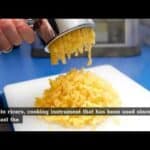You know, to get the best potato ricer all you need is potato ricer buyer’s guide to get the best one.
You don’t know what you’ve been missing out on if you’ve always made mashed potatoes with a masher. A potato ricer makes fluffy, homogeneous mashed potatoes without the sticky potato glue that often results from excess mashing. Looking for the best potato ricer? we have a recommendation for you.
A potato ricer’s utility isn’t limited to making flawless mashed potatoes, either. You can prepare gnocchi, baby food, and even fresh fruit juices with this handy kitchen appliance.
But, before you rush out to the market to get a new potato ricer, keep in mind that there are a number of options. And they aren’t all made equal. To help you narrow down your options, we’ve compiled a list of the top five potato ricers and reviewed them below. Now that you’ve seen the top potato ricers, you can decide which one is right for you. To assist you in making your final decision, our handy buyer’s guide will walk you through all of the different features offered as well as some additional factors to consider.
Potato Ricer Buyer’s Guide: Size of Holes
Ricers can be used for a lot more than mashed potatoes. However, the size of the holes in the hopper will determine how adaptable your ricer is. Fine holes are ideal for making silky smooth mashed potatoes and pureed vegetables. They’re also useful for extracting water from fine greens and shredded potatoes, as well as creating non-pulpy citrus juice.
For making homemade spaetzle or mashing hard-boiled eggs for egg salad, medium holes are preferable. These wider holes will work better if you prefer chunkier mashed potatoes and pulpier citrus liquids.
Large holes are ideal for chunky applesauce and other pressed foods made with raw or al dente ingredients. If you don’t mind a lot of pulp and maybe a few seeds, they also lend themselves to speedier juicing.
Interchangeable discs with various hole sizes are included with some potato ricers. If you want to use your ricer for a variety of tasks, this is a nice function to have. However, hoppers with a fixed hole size are frequently less burdensome to operate and store if you only have one application in mind.
Potato Ricer Buyer’s Guide: Size of Hopper
Another key factor to consider is the hopper’s size. Large hoppers are ideal for speeding up the process of finishing that pot of cooked russets. However, pressing a full potato requires a lot more effort than pressing a slice of one. While a small hopper demands less force from you, it also necessitates more effort.
Before you start mashing, you’ll need to chop your potatoes and vegetables into smaller parts. When picking a ricer, attempt to find a balance between the amount of prep work required to put items into the hopper and the amount of physical effort required to mash what you can fit in there.
Potato Ricer Buyer’s Guide: Handle Strength and Comfort
Ricers are a simple tool that must withstand a great deal of force. That means these tiny devices must be well-made. The handles, in particular, must be able to withstand the torque you want to apply. Look for metal products with a single component that extends around the hopper and through each handle, rather than plastic. Any joints along the handles are ripe for breaking.
You’ll want a handle that is comfortable to grip in addition to being strong. Many include extra rubber padding to relieve some of the pressure on your hands when you squeeze. Ergonomic handles that are positioned to relieve wrist pressure are likewise a good option. The Joseph Joseph Helix ricer, one of our top picks, takes this concept to the next level by eliminating the need to squeeze the handles entirely.
Potato Ricer Buyer’s Guide: Ease of Cleaning
Cleaning a ricer, like cleaning a cheese grater or a garlic press, can be a pain. The more holes there are to scrub, the larger the ricer will be. Smaller ricers, on the other hand, aren’t much easier to clean. It can be difficult to fit a sponge or washcloth into a small hopper.
To make this task easier, many stainless steel potato ricers may be put in the dishwasher. However, unless you have a super-powerful dishwasher, don’t expect a dirty hopper to come out spotless. Most of the time, you’ll need to rinse the instrument well before putting it in with your other dishes.
Look for ricers that can be easily separated into two parts. This will provide you with the most convenient access to the interior of the building.
Was this helpful?
Hi there! I’m a food enthusiast and journalist, and I have a real passion for food that goes beyond the kitchen. I love my dream job and I’m lucky enough to be able to share my knowledge with readers of several large media outlets. My specialty is writing engaging food-related content, and I take pride in being able to connect with my audience. I’m known for my creativity in the kitchen, and I’m confident that I can be the perfect guide for anyone looking to take their culinary journey to the next level.








